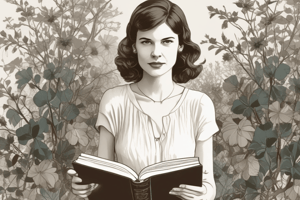Podcast
Questions and Answers
In 'Elm', what is the significance of the phrase 'hooks' in the poem, and what emotion does it evoke?
In 'Elm', what is the significance of the phrase 'hooks' in the poem, and what emotion does it evoke?
The phrase 'hooks' evokes a sense of desperation, conveying the speaker's yearning for something to love.
In 'Elm' how does the poem use natural imagery to convey the speaker's emotional state?
In 'Elm' how does the poem use natural imagery to convey the speaker's emotional state?
The poem uses natural imagery, such as clouds and trees, to convey the speaker's feelings of disconnection, isolation, and despair.
In 'Elm' what is the significance of the 'malignity' in the poem, and how does it relate to the speaker's experience of depression?
In 'Elm' what is the significance of the 'malignity' in the poem, and how does it relate to the speaker's experience of depression?
The 'malignity' refers to the dark, sinister aspect of the speaker's depression, which is deceptive in its 'soft, feathery turnings' but ultimately destructive.
In 'Elm' how does the poem blur the lines between the speaker's voice and the voice of the tree?
In 'Elm' how does the poem blur the lines between the speaker's voice and the voice of the tree?
In 'Elm', what is the significance of the repetition of the phrase 'that kill, that kill, that kill' in the final stanza?
In 'Elm', what is the significance of the repetition of the phrase 'that kill, that kill, that kill' in the final stanza?
Flashcards are hidden until you start studying
Study Notes
Elm by Sylvia Plath
- The poem "Elm" is dedicated to Ruth Fainlight, a fellow American poet of the same age as Plath.
- The poem explores the concept of inner turmoil, depression, and mental health through the conversation between a girl and an elm tree.
Themes and Ideas
- Depression
- Mental Health / Anxiety
- Psychic Landscape
- The importance of communication
Style
- Personification of the elm tree
- Imagined, psychic landscape
- Sound effects (sibilance in particular)
- Repetition
- Provocative imagery (visual, kinesthetic, auditory)
- Imagery from the natural world (elm, moon, sea, wind)
- Figurative language (wind as a metaphor for Plath's depression)
Analysis of Key Quotes
- "I know the bottom, she says. I know it with my great tap root: / It is what you fear." - The elm tree's voice, with the "great tap root" suggesting understanding of suffering.
- "Is it the sea you hear in me, / Its dissatisfactions? / Or the voice of nothing, that was your madness?" - The elm's voice, with aural imagery and hints at deep-rooted fear.
- "Love is a shadow. / How you lie and cry after it" - The girl's response, with the elm's mocking tone.
- "Listen: these are its hooves: it has gone off, like a horse" - The elm's simile, creating a sense of abandonment.
- "All night I shall gallop thus, impetuously, / Till your head is a stone, your pillow a little turf, / Echoing, echoing" - The elm's voice, portraying the overwhelming of inner thoughts and fears.
- "Or shall I bring you the sound of poisons? / This is rain now, this big hush. / And this is the fruit of it: tin-white, like arsenic" - The elm's offer, with a shift in mood and a pathetic fallacy.
- "I have suffered the atrocity of sunsets. / Scorched to the root / My red filaments burn and stand, a hand of wires" - The elm's empathetic tone, using nature to explore mental health.
- "Now I break up into pieces that fly about like clubs. / A wind of such violence / Will tolerate no bystanding: I must shriek" - The wind as a metaphor for depression, with onomatopoeic effect.
- "The moon, also, is merciless: she would drag me / Cruelly, being barren. / Her radiance scathes me" - The personification of the moon, with its radiance burning.
- "I let her go. / I let her go / Diminished and flat, as after radical surgery" - The struggle between the tree and the moon, with the repetition highlighting tiredness.
- "I am inhabited by a cry. / Nightly it flaps out / Looking, with its hooks, for something to love" - The elm's metaphor for depression, with the word "hooks" evoking desperation.
- "I am terrified by this dark thing / That sleeps in me; / All day I feel its soft, feathery turnings, its malignity" - The tactile image of mental suffering, with the "soft" and "feathery turnings" being uncomfortable.
- "Clouds pass and disperse. / Are those the faces of love, those pale irretrievables? / Is it for such I agitate my heart?" - The natural landscape, with the "clouds" reminding of people who move on.
- "I am incapable of more knowledge. / What is this, this face / So murderous in its strangle of branches? / Its snaky acids hiss. / It petrifies the will" - The final stanzas, merging the voices, with the repetition of "kill" emphasizing the destructive nature of depression.
Studying That Suits You
Use AI to generate personalized quizzes and flashcards to suit your learning preferences.




